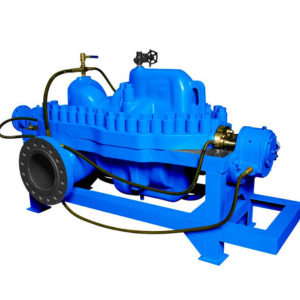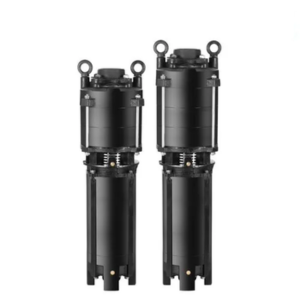Multi stage Pumps in India
Dealers, Distributors and Suppliers of multi stage pumps from India for various mission critical applications. we offer Horizontal Multistage Pumps, Vertical Multistage Pumps, and Multi-Stage Centrifugal Pump customized to respective application.
Multi stage pumps are a versatile category of centrifugal pumps known for their exceptional ability to generate high pressure or head, making them invaluable across various industries. The head of a single-stage centrifugal pump is primarily determined by the impeller type and circumferential speed. When increasing rotational speed isn’t feasible due to operational constraints, and enlarging the impeller diameter would result in inefficient performance due to low specific speeds, adding multiple stages in series (refer to Series operation) becomes a cost-effective way to raise the head. With the dimensions and speeds kept constant, adjusting the number of stages in a multistage pump allows the flow rate to stay the same while the head and power input increase in direct proportion to the number of stages.
Horizontal Multistage Pumps
Vertical Multi-Stage Pumps
Axial Split-Case Multi-Stage Pumps
Submersible Multi-Stage Pumps
Multi Stage Centrifugal Pump
Multi-Stage Centrifugal Pump Specification
| Stages | Multi-Stage |
| Max Flow Rate | 0 to 110 m3/hr |
| Material | Stainless Steel |
| Power Source | Electric |
| Cooling Method | Air Cooled |
| Speed | 2900 rpm |
| Automation Grade | Automatic |
| Power | 0.37 to 55 kW |
| Maximum Working Temperature |
105 Degree Centigrade
|
| Brands | Ebara, CRI, Lubi, Kirloskar and many other brands |
Horizontal Multi Stage Pumps
Horizontal Multi Stage Pump Spectification:
Horizontal multi-stage pumps are characterized by their horizontally aligned shafts and multiple impellers stacked in series. This design allows for efficient handling of pressurized fluids.
Working Principle:
1. Fluid enters through the inlet and is drawn into the first impeller.
2. Each successive impeller further increases the fluid’s kinetic energy and pressure.
3. The pressurized fluid exits through the outlet at significantly higher pressure.
Specifications:
| Flow Rate: | Variable, depending on the design and size, ranging from a few gallons per minute (LPM) to thousands of LPM. |
| Head (Pressure): | Suited for high-pressure applications, often exceeding 1,000 feet. |
Applications:
- Boiler feedwater in power plants.
- Water supply for high-rise buildings.
- Industrial processes requiring elevated pressure.
- Municipal water distribution systems.
Vertical Multi Stage Pumps
Vertical Multi Stage Pumps
Vertical multi-stage pumps are designed with a vertical shaft and multiple impellers. They are ideal for applications where space constraints or specific installation requirements necessitate a vertical configuration.
Working Principle:
1. Fluid enters through the inlet and passes through each impeller stage, with pressure incrementally increasing.
2. The pressurized fluid exits either upward or downward through the pump, depending on the design.
Specifications:
| Flow Rate: | Variable, similar to horizontal multi-stage pumps, ranging from a few LPM to thousands of LPM. |
| Head (Pressure): | Suitable for moderate to high head applications, often between 50 to 1,000 feet. |
Applications:
- Deep-well pumping for groundwater.
- Sump and sewage pumping.
- Industrial wastewater treatment.
- Applications where vertical installation is advantageous.
Axial Split Case Multi Stage Pumps
Axial Split Case Multi Stage Pumps
Axial split-case multi-stage pumps combine the features of axial flow and radial flow pumps. They are designed to handle high flow rates and moderate to high head requirements.
Working Principle:
1. Fluid enters through the inlet and is initially subjected to axial flow impellers, imparting kinetic energy and velocity.
2. Subsequent radial flow impellers further increase the fluid’s pressure.
3. The pressurized fluid exits through the outlet at an angle between axial and radial directions.
Specifications:
| Flow Rate: | High flow rates, often ranging from thousands to hundreds of thousands of LPM. |
| Head (Pressure): | Suited for applications requiring high head, typically exceeding 100 feet. |
Applications:
- Agricultural irrigation.
- Stormwater management.
- Large-scale industrial processes.
- Applications where a balance of flow and pressure is essential.
Submersible Multi-Stage Pumps
Submersible Multi-Stage Pumps:
Submersible multi-stage pumps are designed to be immersed in the fluid they pump, with sealed components to prevent liquid from entering the motor. They are suitable for underwater applications.
Working Principle:
1. The impellers rotate, drawing in fluid through the intake.
2. The pressurized fluid is discharged at the required level, often deep underwater.
Specifications:
| Flow Rate: | Variable, ranging from a few LPM to thousands of LPM. |
| Head (Pressure): | Suited for a wide range of pressure requirements. |
Applications:
- Water well pumping.
- Sewage and wastewater handling.
- Groundwater drainage.
- Underwater applications and marine use.
Benefits and Features of Multi-Stage Pumps:
Multi-stage pumps are versatile and efficient fluid transfer solutions used across various industries. They offer a range of benefits and features that make them a preferred choice for applications requiring high pressure or head. Here are some key advantages and features of multi-stage pumps:
Benefits:
1. High-Pressure Generation: Multi-stage pumps are renowned for their ability to generate high pressures, making them ideal for applications that require pressurized fluid, such as boiler feedwater in power plants or water supply in tall buildings.
2. Energy Efficiency: These pumps are designed for optimal efficiency, reducing energy consumption and operating costs. Their ability to generate high pressure with lower power input contributes to energy savings.
3. Compact Design: Multi-stage pumps provide high-pressure performance in a relatively compact footprint. This space-saving design is valuable in installations with limited space availability.
4. Versatility: They can handle a wide range of fluids, from clean water to chemicals, making them suitable for various industries, including agriculture, manufacturing, and municipal services.
5. Customizable: Many multi-stage pump models are customizable to suit specific application requirements. This adaptability allows for tailored solutions that meet precise needs.
6. Longevity: Properly maintained multi-stage pumps are known for their durability and longevity, providing reliable performance over an extended service life.
Features:
1. Multiple Impellers: Multi-stage pumps feature multiple impellers mounted on a single shaft. These impellers work in series, increasing the fluid’s pressure stage by stage.
2. High-Performance Materials: They are often constructed using materials resistant to corrosion and wear, ensuring longevity and reliability even when handling aggressive fluids.
3. Balanced Design: Multi-stage pumps are engineered with balanced components to minimize vibration and reduce stress on bearings and seals, enhancing their operational stability.
4. Efficient Hydraulic Design: Their hydraulic design is optimized for efficient fluid flow and pressure generation, contributing to their high performance and energy efficiency.
5. Sealed Motors: In submersible multi-stage pumps, motors are hermetically sealed to prevent liquid from entering the motor housing. This design is crucial for underwater applications.
6. Variable Speed Control: Some multi-stage pumps can be equipped with variable frequency drives (VFDs) to control motor speed, allowing for precise adjustments of flow and pressure according to changing system demands.
7. Low NPSH Requirement: Many multi-stage pumps have a low Net Positive Suction Head (NPSH) requirement, making them suitable for applications with limited suction heads available.
8. Silent Operation: Their balanced design and smooth operation often result in minimal noise, making them suitable for installations where noise reduction is essential.
FAQ
Technical FAQ for Multi-Stage Pumps
What is a multi-stage pump, and how does it differ from single-stage pumps?
A multi-stage pump is a type of centrifugal pump with multiple impellers arranged in series. Unlike single-stage pumps with a single impeller, multi-stage pumps can generate significantly higher pressure by increasing the fluid’s pressure stage by stage
What are the typical applications of multi-stage pumps?
Multi-stage pumps are commonly used for applications requiring high pressure or head, including boiler feedwater in power plants, water supply for tall buildings, industrial processes, irrigation, and municipal water distribution.
What are the advantages of using a multi-stage pump over other pump types?
Multi-stage pumps offer benefits such as high-pressure generation, energy efficiency, compact design, versatility in handling various fluids, and customization options to meet specific application requirements.
Can multi-stage pumps handle abrasive or corrosive fluids?
Yes, multi-stage pumps can handle abrasive and corrosive fluids, but the selection of materials and coatings is crucial to ensure compatibility and longevity when dealing with such fluids.
What maintenance practices are essential for multi-stage pumps?
Regular maintenance includes inspecting and cleaning the pump, monitoring for leaks, lubricating bearings, checking motor alignment, and ensuring that impellers are in good condition. Follow the manufacturer’s recommended maintenance intervals.
What is cavitation, and how can it be prevented in multi-stage pumps?
Cavitation occurs when low pressure in the pump causes the formation of vapor bubbles in the fluid, potentially leading to damage. To prevent cavitation, ensure that the pump operates within its design parameters, maintain sufficient inlet pressure, and monitor system conditions closely.
Can multi-stage pumps be used for high-temperature fluids?
Multi-stage pumps can handle high-temperature fluids, but the materials used in the pump’s construction must be suitable for the specific temperature range of the fluid being pumped.
What is Net Positive Suction Head (NPSH), and why is it important for multi-stage pumps?
NPSH is the measurement of the pressure available at the pump’s inlet to prevent cavitation. Multi-stage pumps often have low NPSH requirements, meaning they can operate efficiently even with limited suction head available.
Are multi-stage pumps suitable for underwater applications?
Submersible multi-stage pumps are designed for underwater use, featuring sealed motors to prevent liquid from entering the motor housing. They are commonly used in underwater applications like well pumping and sewage handling.
Can multi-stage pumps be controlled for variable flow and pressure?
Yes, some multi-stage pumps can be equipped with variable frequency drives (VFDs) to control motor speed, allowing for precise adjustments of flow and pressure according to changing system demands.
What are the key factors to consider when selecting a multi-stage pump for a specific application?
Factors to consider include flow rate, required pressure or head, fluid properties, temperature, system design, and space constraints. Consulting with pump manufacturers or engineers can help ensure the right pump is selected.
Are there safety precautions to follow when working with multi-stage pumps?
Yes, safety precautions include following electrical safety practices for pumps powered by electricity, lockout-tagout procedures during maintenance, wearing appropriate personal protective equipment (PPE), and handling chemicals or hazardous fluids with care.





